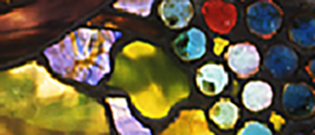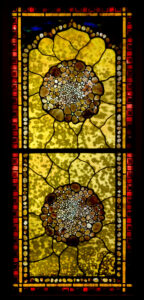In the early decades of the nineteenth century, stained glass in America was like many other forms of American design: reliant on the tastes, trends, and techniques of Europe. The art of stained glass was a centuries-old and time-honored tradition; both European and American artists of the period used methods and materials established in the Middle Ages. These included conventional approaches to coloring glass with surface-applied enamels and stains, hence the popular term “stained glass.” As a result, many of the windows produced during that time shared a similar visual aesthetic inherited from the medieval period.
In the 1870s, artists Louis Comfort Tiffany (1848–1933) and John La Farge (1835–1910) began experimenting with opalescent glass, a semi-opaque and light-diffusing material used primarily in pressed glass tableware. When adapted to the new American glass windows, opalescent glass radically transformed the industry. The naturalistic aesthetic became immensely popular with patrons, divided the glass art community, and necessitated a change in vocabulary to the term “leaded glass.” Leaded-glass windows refer to those composed of any type of colored glass (stained or opalescent) joined by lead lines.
In spite of differing opinions, opalescent glass remained a commercial success through the early decades of the twentieth century. Through the First World War and the approaching depression, opalescent glass continued to be used in the American Arts & Crafts movement and remains popular in architectural decoration today. Bringing together leaded-glass windows, design drawings, and archival materials, Breaking Tradition examines an important period of glass history, reflecting on medieval influences and nineteenth-century developments.



